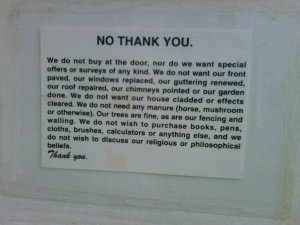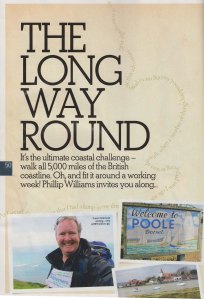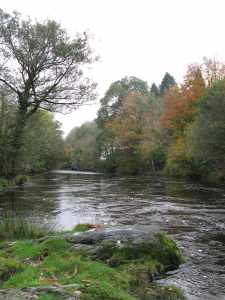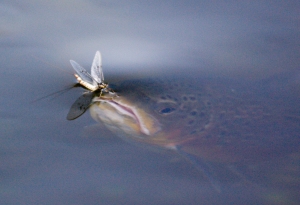
Have you ever wondered what it must be like to step out of the back of an aircraft and fall to earth? If the answer is “yes”, read on!
On a warm and sunny July afternoon a few years ago, I was invited to experience the incredible sensation of freefalling as the guest of former world champion freefaller Eddie Carroll. Eddie had served with the Parachute Regiment before joining the RAF’s elite “Falcons” freefall display team, where he spent a number of years touring the world putting on freefall demonstrations at major international events (amongst other things).
Eddie is a real character – a short and stocky man with a cheeky schoolboy grin and a mat of curly hair. He oozed confidence, and I immediately warmed to the guy. As far as you were concerned, when it came to skydiving, with Eddie around, nothing could go wrong. And if it did go wrong, you could end up, erm, dead.
“Best way to go, mate” he assured me, slapping me on the back as we headed for the back of the Shorts Sky Van aircraft which was to be our jump aircraft for that afternoon. “Life’s there for living. Sure, there are risks involved with skydiving, but part of the buzz is living with the risk, and making sure that the risk is kept to a minimum. In other words, managing the risk. The equipment’s sound, and the parachute is packed carefully. Do you know how they maintain quality control of the RAF’s parachute packing line? The CO will walk into the hanger unannounced, select a parachute from the bench at random, and hand it to one of the packers. That packer has to jump out of an aircraft with that parachute strapped to his back. You bet they pack them carefully! Now and then a chute will fail, but it’s nobody’s fault really. It just happens. We have a reserve chute, and we’re trained to deal with a canopy malfunction. You cut away the main chute using a sharp knife, and then hope there’s enough altitude and time to pull your reserve.”
Eddie had seen his fair share of tragedy, and over the years had developed a black sense of humour to cope with it. I was in an office with him some time before when he received a telephone call from a colleague in the States telling him that one of his best mates had just jumped off a bridge to his death following a drunken row with his girlfriend. After hanging up, Eddie just said, “My best mate had a drink and thought he could fly!” We went straight down to the pub at Eddie’s request to toast his friend, and that was it: get on with life.
Once I had climbed through the large rear door of the aircraft and moved to the back we prepared to clip ourselves together. I was wearing a body harness which was pulled very tight to ensure that when Eddie and I were clipped together, we were as close to being one body mass as possible to ensure that our descent to earth was as uncomplicated as it could be. Eddie was the pilot, and I was the passenger along for the ride. So that we could freefall as easily as possible, I had been shown a few simple drills on the ground to ensure that my pilot was able to have full control. Basically, if I flapped my arms and legs around like a bird, it would be harder for Eddie to control our descent.
There were other skydivers with us, all very experienced and they seemed relaxed as they made themselves comfortable on the floor of the aircraft.
I stood in front of Eddie, and he clipped me to the front of his own body harness. He of course, was also wearing the parachute and reserve! We then sat down together, the rear door closed and the twin engines started up.
All of a sudden, I realised that I was minutes away from jumping out of an aircraft at 14,000 feet attached to somebody else, and that up until now I hadn’t really thought this through. The adrenaline started to pump, and I mean really pump. My heart was pounding, and the waiting began.
The pilot came on over the radio and welcomed us aboard and went through his jokey routine of how lunch and drinks would be served shortly after take off. The other guys just chatted and seemed oblivious to the announcement. They had probably heard it a thousand times before.
Rolling along the grass runway the engines were soon powered up and we took to the air and began our climb to 14,000 feet. We seemed to be climbing in a wide circle as we gained height. Eddie tapped me on the shoulder and pointed to the airfield below. It was hard to hear above the drone of the engines and I just relaxed as best I could and waited until further “orders”. We must have been climbing for about twenty five minutes or so when the red light came on and everybody began standing up and checking both their own equipment and that of their neighbour’s. Eddie then told me to get up and someone came over and checked our harness and the parachute, and gave us the OK.
My legs were like jelly. The rear door slowly opened and I could see blue sky, clouds and the green patchwork of fields below. It felt rather strange to have the rear door open at this height and a little draughty as well.
The other jumpers stepped up to the rear of the aircraft and formed three little groups. Some held on to grab rails above and to the side of the door, whilst others held on to the arms of these anchor men. When the green light came on, they all swayed backwards and forwards a couple of times and then jumped out. I could see them falling in to the clouds, wheeling into the blue yonder still holding hands. I would see them on the ground.
Then it was our turn. Eddie told me to lift my knees up and tuck my feet between his legs and behind his bottom. Then I rested the back of my head on his chest. How reassuring! We waddled over to the door and turned round so we were facing into the aircraft. Then we stepped backwards in to space.

I watched the underside of the aircraft drift in to the distance as we fell away.  We performed a couple of controlled somersaults before facing downwards and I caught my first proper glimpse of the ground. Eddie then deployed our drogue shoot to slow our combined descent from around 140 mph to a more sedate 125 miles per hour. This slow down in speed helps relieve some of the pressure on our equipment when the parachute is deployed.
We performed a couple of controlled somersaults before facing downwards and I caught my first proper glimpse of the ground. Eddie then deployed our drogue shoot to slow our combined descent from around 140 mph to a more sedate 125 miles per hour. This slow down in speed helps relieve some of the pressure on our equipment when the parachute is deployed.
The rushing of the wind in my ears, and the feeling of weightlessness just consumed me. I yelled out at the top of my voice “Yeeeehaaaah!!!”. Along side us was an aerial photographer called Darby who was snapping away at us as we fell. He was wearing a helmet with a stills camera strapped to one side and a video camera on the other.
 Imagine leaning out of your car window doing 125 mph on the motorway and you’ll begin to get some idea of the rush! All the time you’re falling, the wind is pushing back the skin on your face, and below you can see a bank of cloud rushing towards you. My eyes were watering slightly despite my goggles as we fell into the cloud. The air momentarily became much cooler and I could feel this on my face.
Imagine leaning out of your car window doing 125 mph on the motorway and you’ll begin to get some idea of the rush! All the time you’re falling, the wind is pushing back the skin on your face, and below you can see a bank of cloud rushing towards you. My eyes were watering slightly despite my goggles as we fell into the cloud. The air momentarily became much cooler and I could feel this on my face.
 Once we had passed through the cloud I could see the ground and this gave me my first real sense of perspective. Above the cloud you were in your own world. Earth didn’t exist, but once you could see the ground slowly coming towards you, your mind starts to think about something called gravity!
Once we had passed through the cloud I could see the ground and this gave me my first real sense of perspective. Above the cloud you were in your own world. Earth didn’t exist, but once you could see the ground slowly coming towards you, your mind starts to think about something called gravity!
We were due to deploy the canopy at around 4,000 feet to give us plenty of time to enjoy the glide in to the landing zone and experience the more sedate side of freefalling.
I started to look for the airfield and could see it off to our right.
I could feel Eddie pressing down on the back of my head through the thin padded cap I was wearing.
Slowly we changed our trajectory and we were making for the drop zone where we were aiming to land.
Eddie tapped the back of my head to indicate that he was about to pull the rip cord and I crossed my arms ready for the sudden deceleration from 125 mph to around 35 mph, all within a few feet! Suddenly there was an almighty jerk and the re-assuring ‘crack’ from above our heads as the canopy successfully opened. “Oooph!”, I gasped.

Despite the fact that I almost lost the ability to sire future generations, I was otherwise completely intact, and I think Eddie was as well!
What a contrast! The air was now almost completely still. There was a gentle breeze on our faces as we glided high above the fields, and the incredible, rocket-like sound of the rushing wind from moments before was gone. Peace and tranquillity at 3,500 feet.
Eddie passed me the toggles on the risers, which are used to steer the canopy. By pulling on the right riser we turned right and pulling on the left steered us to the left. Eddie encouraged me to pull the left riser hard, and we went in to a tight spin. Releasing the pressure on the left toggle and doing the same with the right repeated the merry-go-round ride in reverse.
We descended gently and passed downwind of the landing zone. I could already see the other jumpers on the ground folding their parachutes as we turned in to the wind.
“Knees up to your chest, please mate, and make it look easy, we’re being filmed!”. I did as I was asked and without so much as a scuff of dust, we landed ever so gently on terra firma.
I was quickly unclipped from Eddie and beckoned over to the camera where I was encouraged to pour out my first impressions of free falling.
“Absolutely bloody brilliant. That is the best thing I have ever done. If you ever get the chance,” I announced to the viewers, “Just Do It!”

Suitably impressed, I removed my harness, re-adjusted my personal items and escorted Eddie to the bar for a well-deserved pint.
 I spent a lovely autumnal day last Sunday walking along the bank of the river Dart upstream from New Bridge with Philippa. We parked in the car park, crossed over the bridge and followed the path that is for a time, part of the Two Moors Way. We were hoping to crunch some autumnal leaves as we walked along. Indeed I have been reading some lovely blogs recently on the very subject of leaf crunching. But I’m afraid the leaves we trod on simply flattened into submission beneath the soles of our boots. In the damp and shady environment of the woods that follow the river’s course, they weren’t dry and brittle, but moist and malleable.
I spent a lovely autumnal day last Sunday walking along the bank of the river Dart upstream from New Bridge with Philippa. We parked in the car park, crossed over the bridge and followed the path that is for a time, part of the Two Moors Way. We were hoping to crunch some autumnal leaves as we walked along. Indeed I have been reading some lovely blogs recently on the very subject of leaf crunching. But I’m afraid the leaves we trod on simply flattened into submission beneath the soles of our boots. In the damp and shady environment of the woods that follow the river’s course, they weren’t dry and brittle, but moist and malleable. We ambled past Bellapool Island towards our picnic spot at Sharrah Pool. It is, justifiably, a sought-after resting place and we weren’t alone when we got there. A family of five, mum, dad and three sons were settled in for lunch. The children were in wetsuits exploring the pool with a snorkel and mask. Great fun. I might one day summon up the strength to do the same with a camera and see what lies beneath!
We ambled past Bellapool Island towards our picnic spot at Sharrah Pool. It is, justifiably, a sought-after resting place and we weren’t alone when we got there. A family of five, mum, dad and three sons were settled in for lunch. The children were in wetsuits exploring the pool with a snorkel and mask. Great fun. I might one day summon up the strength to do the same with a camera and see what lies beneath! As I sat there munching my lunch I realised that in a few weeks time this view of the woodland valley will have evolved into a winter scene. There will be fewer leaves on the trees, more water in the river and if the weather rumours are true, heavy snow on the ground.
As I sat there munching my lunch I realised that in a few weeks time this view of the woodland valley will have evolved into a winter scene. There will be fewer leaves on the trees, more water in the river and if the weather rumours are true, heavy snow on the ground.


 “Crunch crunch crunch” go the trainers on the gravel,
“Crunch crunch crunch” go the trainers on the gravel,

 On a final note, let me tell you that before I put the sign up, I retrieved a business card from a pile of junk mail left on our door mat from a website designer offering his services. From a business perspective, it turned out to be like finding a bit of treasure amongst all the junk.
On a final note, let me tell you that before I put the sign up, I retrieved a business card from a pile of junk mail left on our door mat from a website designer offering his services. From a business perspective, it turned out to be like finding a bit of treasure amongst all the junk.




 I visit Donnie & Kate MacDougall who live on the shore of Loch Eriboll on the north west coast of Scotland…
I visit Donnie & Kate MacDougall who live on the shore of Loch Eriboll on the north west coast of Scotland…


 Cedric Robinson (MBE) is the Royal Guide to the Sands at Morecambe Bay. I had a chat with Cedric and his wife Olive…
Cedric Robinson (MBE) is the Royal Guide to the Sands at Morecambe Bay. I had a chat with Cedric and his wife Olive…
 A ‘landau’ is a horse-drawn taxi. I passed David on the Golden Mile in Blackpool in June 2011 and we stopped for a quick chat…
A ‘landau’ is a horse-drawn taxi. I passed David on the Golden Mile in Blackpool in June 2011 and we stopped for a quick chat…
 In August 2011 I met John Bull (right) and Brian Murdoch who were pioneers of the air ambulance and police helicopter service…
In August 2011 I met John Bull (right) and Brian Murdoch who were pioneers of the air ambulance and police helicopter service… April 2010
April 2010 I was on Dartmoor again, trying to get a photograph of a wild otter for my article about their return to every county in England.
I was on Dartmoor again, trying to get a photograph of a wild otter for my article about their return to every county in England.




 Despite the troubles at our beloved Royal Mail I can report that the postal workers of a West Country town have been able to guarantee a special delivery.
Despite the troubles at our beloved Royal Mail I can report that the postal workers of a West Country town have been able to guarantee a special delivery. One strange September day a few years ago, a Dutch chef provided me with a packed lunch containing a magic ingredient. It certainly made my day’s fishing a very vivid and memorable experience.
One strange September day a few years ago, a Dutch chef provided me with a packed lunch containing a magic ingredient. It certainly made my day’s fishing a very vivid and memorable experience.

 We performed a couple of controlled somersaults before facing downwards and I caught my first proper glimpse of the ground. Eddie then deployed our drogue shoot to slow our combined descent from around 140 mph to a more sedate 125 miles per hour. This slow down in speed helps relieve some of the pressure on our equipment when the parachute is deployed.
We performed a couple of controlled somersaults before facing downwards and I caught my first proper glimpse of the ground. Eddie then deployed our drogue shoot to slow our combined descent from around 140 mph to a more sedate 125 miles per hour. This slow down in speed helps relieve some of the pressure on our equipment when the parachute is deployed. Imagine leaning out of your car window doing 125 mph on the motorway and you’ll begin to get some idea of the rush! All the time you’re falling, the wind is pushing back the skin on your face, and below you can see a bank of cloud rushing towards you. My eyes were watering slightly despite my goggles as we fell into the cloud. The air momentarily became much cooler and I could feel this on my face.
Imagine leaning out of your car window doing 125 mph on the motorway and you’ll begin to get some idea of the rush! All the time you’re falling, the wind is pushing back the skin on your face, and below you can see a bank of cloud rushing towards you. My eyes were watering slightly despite my goggles as we fell into the cloud. The air momentarily became much cooler and I could feel this on my face. Once we had passed through the cloud I could see the ground and this gave me my first real sense of perspective. Above the cloud you were in your own world. Earth didn’t exist, but once you could see the ground slowly coming towards you, your mind starts to think about something called gravity!
Once we had passed through the cloud I could see the ground and this gave me my first real sense of perspective. Above the cloud you were in your own world. Earth didn’t exist, but once you could see the ground slowly coming towards you, your mind starts to think about something called gravity!



